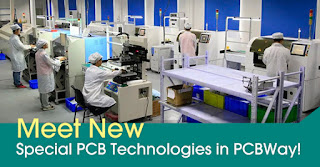Meet New Special PCB Technologies in PCBWay!
As a PCB innovation company, PCBWay is committed to solving the pain
points of PCB procurement and meeting customers' various PCB procurement needs
- offering special plates such as Rogers, copper substrates, aluminum
substrates, and high-frequency high-speed HDI.
Recently, with the efforts of the technical department, PCBWay has
added many special technologies.
1 Impedance control
The resistance encountered by high-frequency signals or electromagnetic
waves in the transmission signal lines of electronic components is called
characteristic impedance. When the digital signal is transmitted on the board,
the characteristic impedance value of the PCB must match the electronic
impedance of the head and tail components. Once there is a mismatch, the
transmitted signal energy will be reflected, scattered, attenuated or delayed,
seriously affecting signal integrity. In this case, impedance control must be
performed to match the characteristic impedance value of the PCB to the
component.
At present, in PCBWay's prototype of FR-4, FPC, rigid-flex board, the
impedance control process can achieve 2-20 layers and the impedance tolerance
is ±10% (limit ±8%).
2. HDI blind buried hole
Blind holes are only visible on one of the top or bottom layers, that
is, blind holes are drilled from the surface, but not through all layers. Buried
holes are through holes in the inner layer, both sides of the hole are inside
the board layers, in other words, holes buried inside the board. The application
of blind buried holes greatly reduces the size and quality of HDI (High-Density
Interconnect) PCBs, reduces the number of layers, improves electromagnetic
compatibility, reduces costs, and also makes PCB design work easier and faster.
At this stage, the application of PCBWay's blind buried hole technology
in the FR-4 prototype has broken through the highest level of 20 layers. The
thickness of the board is ≤6.0mm. The stage
of blind holes is 1~4, the minimum aperture is 0.076mm, and the technology is
laser drilling.
3 Thick copper PCB
Adhere a layer of copper foil on the outer layer of FR-4, when the
copper thickness is 2oz or above, it is defined as a thick copper PCB. The
thick copper PCB has excellent extension performance, high temperature and low
temperature resistance, and corrosion resistance, which allows electronic
equipment products to have a longer service life, and also greatly helps the
size of electronic equipment to be simplified.
At present, PCBWay can achieve 2~6 layers in thick copper PCB technology(more
than 6 layers needs to be reviewed). The maximum copper thickness is 10oz, the
minimum via is 0.4~0.6mm.
4 Multi-layer special stack-up structure
With the continuous emergence of high-speed circuits, the complexity of
PCB boards is getting higher and higher. In order to avoid the interference of
electrical factors, the signal layer and the power layer must be separated, so
multiple layers are involved. The stack-up structure is an important factor
that affects the EMC performance of the PCB, and also an important means to
suppress electromagnetic interference. For the number of signal networks, the
greater the device density, the greater the PIN density, the higher the
frequency of the signal design should try to use a multi-layer special stack-up
structure.
At this stage, the special stacks that PCBWay can do are 2-8 layers.
5 Electroplated nickel gold/gold finger
Nickel electroplating also refers to electroplated gold, electrolytic
gold, etc. It uses electroplating to attach gold particles to the PCB. Because
of its strong adhesion, it is called hard gold; using this process can greatly
increase the hardness and wear resistance of the PCB, and can effectively
prevent the diffusion of copper and other metals. And can meet the requirements
of hot press welding and brazing. The coating can be uniform and meticulous,
with low porosity, low stress, and good ductility. Therefore, it is widely used
in PCB proofing.
6 Electroless Nickel Electroless Palladium Immersion Gold(ENEPIG)
Electroless Nickel Electroless Palladium Immersion Gold(ENEPIG) is to
deposit a layer of nickel, palladium, and gold on the surface of the printed circuit
copper layer by chemical methods in the PCB prototype. It is a non-selective
surface processing technology. It uses 10 nm thick gold plating and 50 nm thick
palladium plating to achieve good electrical conductivity, corrosion resistance, and anti-friction properties. The thickness of its copper layer will directly
affect the various physical and appearance properties mentioned above.
ENEPIG is the latest technology currently used in the PCB prototype.
7 Shaped holes
In the PCB manufacturing process, it is often encountered that the
production of non-circular holes which called special-shaped holes. Including
8-shaped hole, diamond hole, square hole, zigzag hole, etc.. It is mainly
divided into two types: Plated Through Hole (PTH) and Non-Plated Through Hole
(NPTH). For the smallest aperture, PCBWay can achieve 0.2mm.
8 Deep Groove
With the diversified development of electronic products, special
concave fixed components are gradually applied to PCB design, resulting in a
deep groove. At this stage, PCBWay can achieve depth control depth tolerance
±0.1mm, depth control depth aperture ratio 1.3:1 (aperture ≤0.2mm), 1.15:1 (aperture ≥0.25mm), mechanical control
depth drilling depth tolerance ±0.1 mm.





Comments
Post a Comment